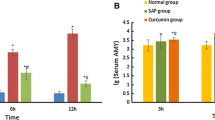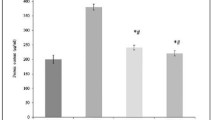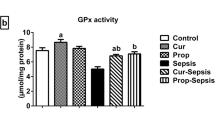Abstract
Despite medical advancements, the inflammatory cascade and oxidative stress worsen the prognosis in most cases of peritonitis. Curcumin has emerged as a potential antioxidant and anti-inflammatory agent in few of the acute inflammatory and infective conditions. We examined the effect of intraperitoneal injection of curcumin in endotoxin-induced peritonitis in rats. The blood and peritoneal fluid samples were collected at 3 and 24 h following the induction of peritonitis. Animals were sacrificed at 24 h and the organs preserved. The histopathological report of lung, liver, and intestines in the curcumin-treated rats showed maintenance of tissue architecture to a large extent compared to the control group which showed massive congestion, hemorrhage, and necrosis. The blood and peritoneal fluid total count and differential neutrophil counts were significantly higher at 24 h of induction of peritonitis. Serum amyloid assay and lipid peroxidation were significantly lower, and myeloperoxidase assay was higher in the curcumin-treated group at the end of 24 h; thus, curcumin probably demonstrated a neutrophil-mediated immunopotentiation and anti-inflammatory action thereby protecting the animal from endotoxemia-induced multi-organ damage.

Similar content being viewed by others
References
Mulier S, Penninckx F, Verwaest C, Filez L, Aerts R, Fieuws S, Lauwers P (2003) Factors affecting mortality in generalized postoperative peritonitis: multivariate analysis in 96 patients. World J Surg 27:379–384
Bosscha K, van Vroonhoven TJ, Werken VC (1999) Surgical management of severe secondary peritonitis. Br J Surg 86:1371–1377
Kumar Y, Singh G, Davidson BR (2007) Free radical and antioxidant levels in patients with secondary peritonitis and their prognostic significance. Dig Surg 24:331–337
Ritter C, Andrades M, Frota Junior ML, Bonatto F, Pinho RA, Polydoro M, Klamt F, Pinheiro CT, Menna-Barreto SS, Moreira JC, Dal Pizzol F (2003) Oxidative parameters and mortality in sepsis induced by cecal ligation and perforation. Intensive Care Med 29:1782–1789
Qadan M, Dajani D, Dickinson, Polk HC (2010) Meta-analysis of the effect of peritoneal lavage on survival in experimental peritonitis. Br J Surg 97:151–159
Bohnen J, Boulanger M, Meakins JL, McLean PA (1983) Prognosis in generalized peritonitis. Arch Surg 118:285–290
Nathens AB, Neff MJ, Jurkovich GJ, Klotz P, Farver K, Ruzinski JT, Radella F, Garcia I, Maier RV (2002) Randomized, prospective trial of antioxidant supplementation in critically ill surgical patients. Ann Surg 236:814–822
Masferrer JL, Zweifel BS, Seibert K, Needleman P (1990) Selective regulation of cellular cyclooxygenase by dexamethasone and endotoxin in mice. J Clin Invest 86:1375–1379
Bondar VM, Rago C, Cottone J, Wilkerson DK, Riggs J (2000) Chlorhexidine lavage in the treatment of experimental intra-abdominal infection. Arch Surg 135:309–314
Chainani-Wu N (2003) Safety and anti-inflammatory activity of curcumin: a component of turmeric (Curcuma longa). J Altern Complement Med 9:161–168
Cohly HH, Taylor A, Angel MF, Salahudeen AK (1998) Effect of turmeric, turmeric and curcumin on H2O2-induced renal epithelial (LLC-PK1) cell injury. Free Radic Biol Med 24:49–54
Strimpakos AS, Sharma RA (2008) Curcumin: preventive and therapeutic properties in laboratory studies and clinical trials. Antioxid Redox Signal 10:511–546
Ukil A, Maity S, Karmakar S, Datta N, Vedasiromoni JR, Das PK (2003) Curcumin, the major component of food flavor turmeric, reduces mucosal injury in trinitrobenzene sulphonic acid-induced colitis. Br J Pharmacol 139:209–218
Yeh CH, Chen TP, Wu YC, Lin YM, Jing Lin P (2005) Inhibition of NFkappaB activation with curcumin attenuates plasma inflammatory cytokines surge and cardiomyocytic apoptosis following cardiac ischemia/reperfusion. J Surg Res 125:109–116
Aggarwal BB, Sung B (2009) Pharmacological basis for the role of curcumin in chronic diseases: an age-old spice with modern targets. Trends Pharmacol Sci 30:85–94
Goel A, Kunnumakkara AB, Aggarwal BB (2008) Curcumin as “Curecumin”: from kitchen to clinic. Biochem Pharmacol 75:787–809
Kunchandy E, Rao MNA (1990) Oxygen radical scavenging activity of curcumin. Int J Pharm 58:237–240
Frank N, Knauft J, Amelung F, Nair J, Wesch H, Bartsch H (2003) No prevention of liver and kidney tumors in Long–Evans Cinnamon rats by dietary curcumin, but inhibition at other sites and of metastases. Mutat Res 523–524:127–135
Suai Z, Salto R, Li J, Craik C, Montellano PRC (1993) Inhibition of the HIV-l and HIV-2 proteases by curcumin and curcumin boron complexes. Bioorg Med Chem 1:415–422
Mahady GB, Pendland SL, Yun G, Lu ZZ (2002) Turmeric (Curcuma longa) and curcumin inhibit the growth of Helicobacter pylori, a group 1 carcinogen. Anticancer Res 22:4179–4181
Singh S, Aggarwal BB (1995) Activation of transcription factor NF-kappa B is suppressed by curcumin (diferuloylmethane) [corrected]. J Biol Chem 270:24995–25000
Jang MK, Sohn DH, Ryu JH (2001) A curcuminoid and sesquiterpenes as inhibitors of macrophage TNFalpha release from Curcuma zedoaria. Planta Med 67:550–552
Gaddipati JP, Sundar SV, Calemine J, Seth P, Sidhu GS, Maheshwari RK (2003) Differential regulation of cytokines and transcription factors in liver by curcumin following hemorrhage/resuscitation. Shock 19:150–156
Biswas SK, McClure D, Jimenez LA, Megson IL, Rahman I (2005) Curcumin induces glutathione biosynthesis and inhibits NF-kappaB activation and interleukin-8 release in alveolar epithelial cells: mechanism of free radical scavenging activity. Antioxid Redox Signal 7:32–41
Aggarwal BB, Shishodia S, Takada Y, Banerjee S, Newman RA, Bueso-Ramos CE, Price JE (2005) Curcumin suppresses the paclitaxel-induced nuclear factor-kappaB pathway in breast cancer cells and inhibits lung metastasis of human breast cancer in nude mice. Clin Cancer Res 11:7490–7498
Chan MM, Huang HI, Fenton MR, Fong D (1998) In vivo inhibition of nitric oxide synthase gene expression by curcumin, a cancer preventive natural product with anti-inflammatory properties. Biochem Pharmacol 55:1955–1962
Liacini A, Sylvester J, Li WQ, Zafarullah M (2002) Inhibition of interleukin-1-stimulated MAP kinases, activating protein-1 (AP-1) and nuclear factor kappa B (NF-kappa B) transcription factors downregulates matrix metalloproteinase gene expression in articular chondrocytes. Matrix Biol 21:251–262
Zhang F, Altorki NK, Mestre JR, Subbaramaiah K, Dannenberg AJ (1999) Curcumin inhibits cyclooxygenase-2 transcription in bile acid- and phorbol ester-treated human gastrointestinal epithelial cells. Carcinogenesis 20:445–451
Huang MT, Lysz T, Ferraro T, Abidi TF, Laskin JD, Conney AH (1991) Inhibitory effects of curcumin on in vitro lipoxygenase and cyclooxygenase activities in mouse epidermis. Cancer Res 51:813–819
Kim MH, Liu W, Borjesson DL, Curry F-RE, Miller LS, Cheung AL, Liu FT, Isseroff RR, Simon SI (2008) Dynamics of neutrophil infiltration during cutaneous wound healing and infection using fluorescence imaging. J Invest Dermatol 128(7):1812–1820
Craciun FL, Schuller ER, Remick DG (2010) Early enhanced local neutrophil recruitment in peritonitis-induced sepsis improves bacterial clearance and survival. J Immunol 185:6930–6938
Rey EG, Chorny A, Varela N, Robledo G, Delgado M (2006) Urocortin and adrenomedullin prevent lethal endotoxemia by down-regulating the inflammatory response. Am J Pathol 168:1921–1930
Sandur SK, Ichikawa H, Pandey MK, Kunnumakkara AB, Sung B, Sethi G, Aggarwal BB (2007) Role of prooxidants and antioxidants in the anti-inflammatory and apoptotic effects of curcumin (diferuloylmethane). Free Radic Biol Med 43(4):568–580
Agarwal BB (2011) Do dietary spices impair the patient-reported outcomes for stapled hemorrhoidopexy? A randomized controlled study. Surg Endosc 25:1535–1540
Agarwal KA, Tripathi CD, Agarwal BB, Saluja S (2011) Efficacy of turmeric (curcumin) in pain and postoperative fatigue after laparoscopic cholecystectomy: a double-blind, randomized placebo-controlled study. Surg Endosc 25:3805–3810
Acknowledgments
We thank Dr. J Prakasa Rao for the advice and encouragement. We thank Rajiv Gandhi University of Health Sciences (RGUHS), Karnataka, India for funding the study.
Ethical Approval
All applicable institutional guidelines for the care and use of animals were followed. All procedures performed in studies involving animals were in accordance with the ethical standards of the institution or practice at which the studies were conducted.
Funding
This study was funded by Rajiv Gandhi University of Health Sciences (RGUHS), Karnataka, India (Grant No: RGUHS/R&D/Research Grants/M13/2012-13).
Conflict of Interest
The authors declare that they have no competing interests.
Author information
Authors and Affiliations
Corresponding author
Rights and permissions
About this article
Cite this article
D, S., Mani, I., Ravikumar, G. et al. Effect of Curcumin in Experimental Peritonitis. Indian J Surg 77, 502–507 (2015). https://doi.org/10.1007/s12262-015-1303-y
Received:
Accepted:
Published:
Issue Date:
DOI: https://doi.org/10.1007/s12262-015-1303-y




